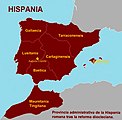History of the territorial organization of Spain
The history of the territorial organization of Spain, in the modern sense, is a process that began in the 16th century with the dynastic union of the Crown of Aragon and the Crown of Castile, the conquest of the Kingdom of Granada and later the Kingdom of Navarre. However, it is important to clarify the origin of the toponym Spain, as well as the territorial divisions that existed previously in the current Spanish territory.
Definition of Spain
The name Spain derives from Hispania, the name by which the Romans geographically designated the Iberian Peninsula as a whole, an alternative term to the name Iberia, preferred by Greek authors to refer to the same space. This name was kept after the fall of the Roman Empire as a designation of the peninsula under the Goths and among the Greco-Latin Christian world. After the Arab conquest, the part of the peninsula controlled by the Moors was called, for centuries, Al Ándalus or alternatively Spania, although the process of Reconquest ended up eliminating these names.
The unification of the various kingdoms of that geographical region led to a correspondence between that region and a single state during the brief period of union of Spain and Portugal, which ended in 1640. Since then, Spain has been explicitly used to refer to the current country of that name, while Iberia is preferred to encompass Iberia and Portugal.
This article will discuss the territorial organization of Spain throughout history, although the organization of other peninsular or bordering areas will be included when imposing the current borders is anachronistic.
Pre-Roman period
The Iberian Peninsula was originally occupied by peoples of different origins (Indo-European, Iberian or of unknown ethnogeny such as Cantabri, Varduli and Vascones). These peoples did not carry out any administrative division, organizing themselves as cities or tribes independent of each other.
Later, some historians have tried to create families of tribes that share the same cultural characteristics, particularly distinguishing between Iberians in the Levant and south of the peninsula, Celts in the plateau and Vascones and Cantabri in the north. The limits between one area and another are a matter of discussion, with no agreement as to whether or not to include peoples such as the Lusitanians among the Celts or as peoples per se. These classifications do not imply that there was a common administrative organization among these tribes.
| Pre-Roman peoples and their linguistic affiliation prior to the conquest | |
|---|---|
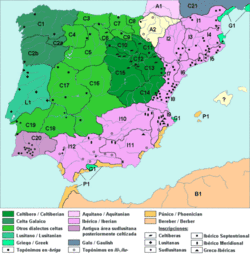 |
C1: Gallaeci / C2b: Bracari C3: Cantabri / C4: Astures / C5: Vaccei / C6: Turmodigi / C7: Autrigones-Caristii / C8: Varduli / C9: Berones C10: Pellendones / C11: Belli / C12: Lusones / C13: Titii / C14: Olcades / C15: Arevaci C16: Carpetani / C17: Vettones / C18-C19: Celtici / C20: Cynetes / L1: Lusitanians |
| A1: Aquitani / A2: Vascones I1: Ceretani / I2: Ilergetes / I3: Lacetani / I4: Indigetes / I5: Laietani / I6: Ilercavones / I7: Sedetani / I8: Edetani / I9: Contestani / I10: Oretani / I11: Bastetani / I12: Turdetani | |
| G1: Greeks / P1: Phoenicians / Carthaginians / B1: Berbers | |
Roman division
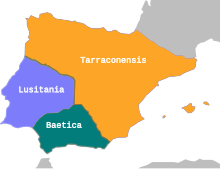
The Romans carried out various divisions of the peninsula throughout the history of their Empire:
- Division of 197 B.C. (its limits were not precise, since only the coastline was dominated):
- Hispania Citerior: Ebro Valley and Mediterranean coast.
- Hispania Ulterior: Guadalquivir Valley.
- Division in the High Roman Empire in three provinces divided in juridical convents:
- Diocese Hispaniarum (3rd century) divided into six (later seven) provinces (one of them in North Africa):
- Tarraconensis
- Carthaginensis
- Baetica
- Lusitania
- Gallaecia
- Balearica: this division appeared in the middle of the 4th century, under the reign of Constantius I and Constantine II.
- Mauretania Tingitana.
-
Division made during the Roman domination in conventus, ancestor of the current judicial districts.
-
Provincial division by Diocletian in 298.
Barbarian and Muslim kingdoms

With the fall of the Roman Empire, the Suebi, Visigoths and other peoples occupied most of the peninsula. Finally, the Visigoths gained control of the entire peninsula in the 6th century after conquering the Suebi kingdom. They maintained the Roman provincial administrative division (under the name of "duchies") and even created new duchies, such as Asturias and Cantabria, and the province of Celtiberia and Carpetani.
From 711, the Muslims conquered the peninsula and continued to control part of it until 1492, the year in which Granada was taken. The Muslim kingdom was divided into coras or kūras, all of which depended on a city. Later, as Muslim power declined, the coras became independent, creating small states with their own king, the so-called Taifa kingdoms.
Reconquest
With the Reconquest several kingdoms were created: the Kingdom of Asturias (718), which claimed Visigothic legitimacy and became known as the Kingdom of León in 925, from which the Kingdom of Castile became independent in 1065 and the Kingdom of Portugal in 1139. The Kingdom of Galicia was also created in 910, intermittently independent of the Kingdom of León but subordinate to it (910–914, 926–929, 981–984, 1065–1073).
With the Catholic Monarchs, each of these kingdoms maintained its own administrative divisions: in Castile, the provinces, and in the Crown of Aragon: districts in Aragon, vegueries in Catalonia and Mallorca, and in Valencia there were four governorates and eleven districts.
16th century
Crown of Castile
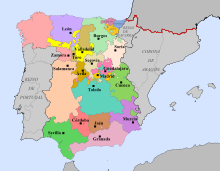
The territory of the kingdom of Castile was distributed among the 18 cities with the right to vote in Cortes and in turn subdivided into partidos, which in the census of 1591-1594 are not called that way, receiving in some cases also the name of province.
These circumscriptions created at the end of the 16th century, which were sometimes called provinces, lacked any legal or administrative value and were merely fiscal in nature, so that it is important to avoid confusing this concept of province with the current one,[1] and did not constitute an administrative division at all. The only real administrative division existing at that time was the town and the municipality. There were also other structures, such as corregimientos, dioceses or lordships:
- Burgos, with Trasmiera, capital: Laredo and Tierras del Condestable, capital: Villalpando.
- Soria.
- Valladolid, with Tierras del Conde de Benavente, capital: Benavente.
- León, with Principality of Asturias of Oviedo, capital: Oviedo and Ponferrada.
- Zamora, with the Bishopric of Lugo, La Coruña and Betanzos, Orense, Mondoñedo, Santiago de Compostela and Tuy.
- Toro, with the District of Carrión and the District of Reinosa.
- Salamanca, with Trujillo and the province of León of the Order of Santiago, capital: Llerena.
- Avila.
- Segovia.
- Guadalajara.
- Madrid.
- Kingdom of Toledo, with Campo de Calatrava, capital: Almagro; Archbishop's Table of Toledo, capital: Talavera, Castile of the Order of Santiago, capital: Ocaña; Alfoz de Alcaraz, capital: Alcaraz; Castile of Campo de Montiel, capital: Infantes and Ciudad Real.
- Cuenca, with Huete.
- Kingdom of Murcia;
- Kingdom of Seville;
- Kingdom of Cordoba;
- Kingdom of Jaén, with Calatrava del Andalucía, capital: Martos;
- Kingdom of Granada.

Crown of Aragon
- Kingdom of Aragon;
- Kingdom of Valencia, with two governorates with capitals in Valencia and Orihuela, and two sub-governments with capitals in Castellón and Xàtiva.
- Kingdom of Majorca.
- Principality of Catalonia, with twelve vegueries with capitals in Tortosa, Tarragona, Montblanc, Barcelona, Vic, Manresa, Vilafranca del Penedès, Girona, Camprodon, Lleida, Tàrrega and Cervera.
Kingdom of Navarre
Intendencies of 1720

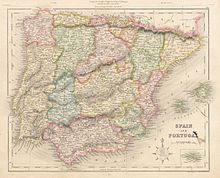
Philip V created, taking as a base the pre-existing provinces created by the Austrias, the institution of the intendancies. Although it is true that these did not always coincide with the limits of the provinces, so there was some opposition to this division.
Twenty were the intendancies then created: those of La Coruña, León, Valladolid, Burgos, Pamplona, Zaragoza, Barcelona, Salamanca, Ávila, Guadalajara, Toledo, Madrid, Ciudad Real, Valencia, Mérida, Seville, Córdoba, Granada, Palma and Santa Cruz de Tenerife.
Ferdinand VI rearranged the limits of the intendancies, making them coincide with the provinces of the Austrias and the former kingdoms of Spain.
Tomás González Hernández, headmaster of the Cathedral Church of Plasencia, reorganizes the Royal Archive of Simancas, after the despoilment suffered after the Napoleonic invasion. His work Census of the population of the Provinces and Districts of the Crown of Castile in the 16th century has constituted the only published source to know the Spanish population in the time of the Austrias. The archivist completes the so-called Book of the Millions with data from other regions: Catalonia, Basque Country, Navarre, Valencia and Aragon.
Under the reign of Carlos III, on March 22, 1785, the Count of Floridablanca promoted the creation of a Prontuario or nomenclator of the towns of Spain and maps were drawn up to facilitate the control of the kingdom:
At the end of the Ancient Regime the local jurisdictions offered a picture even more obsolete and anachronistic than that of the old provinces; distributed in royal, abadengas and secular lordship jurisdictions, they were the result of historical circumstances accumulated over the centuries and represented the antithesis of rationality and administrative efficiency.[3]
19th century
During the 19th century, Spain witnessed a struggle between the Ancient Regime and the liberal State, with two antagonistic concepts of government. The liberal State needed a new territorial organization that would allow it to govern the country in a uniform manner, collect taxes and create a single market with equal laws for all.
Soler Plan of 1799
At the beginning of the 19th century, a new division of the territory of Spain was carried out on the basis of Enlightenment criticism of the previous division. This division was part of a project to reorganise the territory promoted by Miguel Cayetano Soler, general superintendent of finance, mainly with the intention of simplifying the tax system and rationalising the collection of taxes, so that the new reform gave a greater role to the delegates of the intendant —the subdelegates of revenue— and to the district boards.
One of the most important points of the reform was the creation, by Royal Decree of 25 September 1799 and Instruction of 4 October of the same year, of six maritime provinces, Oviedo, Santander, Alicante, Cartagena, Malaga and Cadiz, which were separated, respectively, from the Intendencies of León, Burgos, Valencia, Murcia, Granada and Seville, all of which were very large provinces.[4] All the provinces created in 1799 have continued to exist in subsequent divisions up to the present day, with the exception of the period under the division into prefectures of 1810, and the province of Cartagena, which disappeared with the last and definitive provincial division of 1833, which is still in force today except for slight modifications.
Prefectures of 1810
The outbreak of the War of Independence in May 1808 established a new order under Napoleon, who put his brother Joseph Bonaparte on the throne. In 1810, the Josephine government tried to order the territory by dividing it into 38 prefectures, in the style of those established in France, and 111 sub-prefectures, according to the project of the engineer and mathematician José María Lanz.[5] The prefectures were to be named after geographical features, mainly rivers and capes. This division made a clean sweep of historical conditions, but it never came into force.

Thirty-eight peninsular prefectures were created, plus the Balearic and Canary Islands:
- Águeda, with its capital at Ciudad Rodrigo (roughly equivalent to the south of what is now the province of Salamanca and the north of Cáceres).
- Subprefectures in Ciudad Rodrigo, Béjar and Navarredonda.
- Arlanzón, with capital at Burgos (equivalent to the centre of the province of Burgos and La Rioja).
- Baleares, with capital in Mallorca, no sub-prefectures.
- Bidasoa, with its capital in Pamplona (equivalent to Navarre).
- Sub-prefectures in Pamplona, San Sebastián and Olite.
- Cabo de la Nao, with capital in Alicante (equivalent to Alicante, south of Valencia and east of Albacete).
- Cabo de Peñas, with capital in Oviedo (equivalent to Asturias, except the lands between the rivers Eo and Navia)
- Cabo Machichaco, with capital in Vitoria (equivalent to the Basque Country).
- Cabo Mayor, with capital in Santander (equivalent to Cantabria).
- Subprefectures in Santander, Laredo and Villarcayo.
- Canarias, with capital in Santa Cruz de Tenerife, no sub-prefectures
- Carrión, with capital in Palencia (equivalent to Palencia)
- Sub-prefectures in Palencia, Carrión de los Condes and Cervera de Pisuerga.
- Cinca y Segre, with capital in Lleida (equivalent to the north-west of the province of Lleida)
- Sub-prefectures in Lleida, Seu d'Urgell and Talarn.
- Duero Alto, with capital in Soria (equivalent to Soria)
- Sub-prefectures in Soria, El Burgo de Osma and Medinaceli.
- Duero y Pisuerga, with capital in Valladolid (equivalent to Valladolid, south of Burgos, Segovia and east of Ávila).
- Sub-prefectures in Valladolid, Aranda de Duero and Segovia
- Ebro, with capital in Tarragona (equivalent to the province of Tarragona, south-east of Lleida, east of Zaragoza, north-east of Teruel and north of Castellón)
- Ebro y Cinca, with capital in Huesca (equivalent to the province of Huesca)
- Ebro y Jalón, with capital in Zaragoza (province of Zaragoza and north of the province of Teruel).
- Esla, with capital in Astorga.
- Genil, with its capital in Granada (provinces of Almería and Granada)
- Guadalaviar Alto, with capital in Teruel (south of the province of Teruel)
- Guadalaviar Bajo, with capital in Valencia (province of Valencia and south of the province of Castellón).
- Sub-prefectures in Valencia, Castellón de la Plana and Segorbe.
- Guadalete, with capital in Jerez de la Frontera (province of Cadiz)
- Sub-prefectures in Jerez de la Frontera, Cádiz and Ronda.
- Guadalquivir Alto, with capital in Jaén (province of Jaén)
- Sub-prefectures in Jaén, Úbeda and La Carolina.
- Guadalquivir Bajo, with capital in Seville (provinces of Huelva and Seville)
- Guadalquivir y Guadajoz, with capital in Cordoba (province of Cordoba)
- Guadiana y Guadajira, with capital in Mérida (province of Badajoz and west of the province of Ciudad Real).
- Jucar Alto, with capital in Cuenca (province of Cuenca)
- Subprefectures in Cuenca and Tarazona de la Mancha.
- Llobregat, with capital in Barcelona (Province of Barcelona)
- Manzanares, with capital in Madrid (city of Madrid and surrounding areas)
- Subprefectures in Madrid and Alcalá de Henares.
- Miño Bajo, with capital in Vigo (province of Pontevedra)
- Sub-prefectures in Vigo, Pontevedra and Tuy.
- Miño Alto, with capital in Lugo (north of the province of Lugo and Asturian lands west of the Navia).
- Ojos del Guadiana, with its capital in Ciudad Real (Ciudad Real province, south of Toledo province and west of Albacete province).
- Subprefectures in Ciudad Real and Alcaraz.
- Salado, with its capital in Málaga (province of Málaga and south-east of the province of Seville).
- Segura, with capital in Murcia (province of Murcia, north-east of Granada province, central part of Albacete province and the Vega Baja del Segura of Alicante province).
- Sub-prefectures in Murcia, Cartagena, Albacete and Huéscar.
- Sil, with capital in Ourense (Province of Ourense and southern part of the Province of Lugo).
- Subprefectures in Orense, Monforte de Lemos and Monterrei.
- Tajo Alto, with capital in Guadalajara (Province of Guadalajara and north-west of the Province of Cuenca).
- Sub-prefectures in Guadalajara, Sigüenza and Huete.
- Tajo y Alagón, with capital in Cáceres (province of Cáceres without its northern third).
- Sub-prefectures in Cáceres, Plasencia and Talavera de la Reina.
- Tajo y Alberche, with capital in Toledo (north of the province of Toledo, from the Tagus, and province of Madrid, without the prefecture of Manzanares).
- Sub-prefectures in Toledo, Ocaña and Casarrubios del Monte.
- Tambre, with capital in A Coruña (province of A Coruña).
- Subprefectures in A Coruña, Santiago de Compostela and Corcubión.
- Ter, with capital in Girona (province of Girona).
- Tormes, with capital in Salamanca (province of Zamora and north of the province of Salamanca).
Although the War of Independence prevented the adoption of all these reforms, in 1812 a decree allowed Catalonia to be annexed to France until 1814 as a new region divided into four departments:
- Department of the Bouches-de-l'Èbre with a prefecture in Lleida and subprefectures in Cervera, Tortosa and Tarragona.
- Department of Montserrat with a prefecture in Barcelona and subprefectures in Manresa and Vilafranca del Penedès.
- Department of Sègre with a prefecture in Puigcerdà and subprefectures in Solsona and Talarn.
- Department of Ter with a prefecture in Girona and subprefectures in Vic and Figueres.
First attempt at provinces
Cortes of Cadiz
In 1811, the Cortes of Cadiz abolished the jurisdictional lordships, thus eliminating the division between seigneurialism and royalty, which, despite the restoration of absolutism by Ferdinand VII in 1814, would not come into force again.
At the same time, the Cortes of Cadiz tried to create a new regime, also liberal, in which all the provinces would have the same obligations. The constitution of 1812 did not recognise the political personality of the former historical territories. This was approved by the deputies of all the provinces, including the American territories. The Cortes came up with a new system that did take into account the historical conditions. Thirty-two provinces were created, according to Floridablanca's nomenclature, with some corrections. But in 1813 they also commissioned a new provincial division from Felipe Bauzá, which determined 36 provinces, with seven subordinate provinces, based on historical criteria. But none of this was approved, and the return of Ferdinand VII meant a return to the Ancient Regime, with certain modifications. In 1817 Spain was divided into 29 intendencies and 13 consulates.
Territorial division of 1822

After General Riego's uprising during the Liberal Triennium (1820–1823), the construction of the Liberal State was promoted, and with it a new provincial division, although the provincial councils of 1813 were recovered first. The idea was that this division would cover the whole country, without exception, and would be the single framework for administrative, governmental, judicial and economic activities, according to criteria of legal equality, unity and efficiency. The project was entrusted to the technicians Felipe Bauzá and José Agustín de Larramendi.
In January 1822, the Cortes provisionally approved a provincial division of Spain into 52 provinces:[6]
- Province of Alicante, with Alicante as its capital.
- Province of Almería, with its capital in Almería.
- Province of Ávila, with its capital in Ávila.
- Province of Badajoz, with its capital in Badajoz.
- Province of Balears (islands), with its capital in Palma.
- Province of Barcelona, with capital in Barcelona.
- Province of Bilbao, with capital in Bilbao.
- Province of Burgos, with capital in Burgos.
- Province of Cáceres, with capital in Cáceres.
- Province of Cádiz, with capital in Cádiz.
- Province of Calatayud, with capital in Calatayud.
- Province of Canary Islands, with capital in Santa Cruz de Tenerife.
- Province of Castellón, with its capital in Castellón de la Plana.
- Province of Ciudad Real, with its capital city in Ciudad Real.
- Province of Chinchilla, with capital in Chinchilla.
- Province of Córdoba, with capital in Córdoba.
- Province of A Coruña, with capital in A Coruña.
- Province of Cuenca, with capital in Cuenca.
- Province of Girona, with capital Girona.
- Province of Granada, with capital in Granada.
- Province of Guadalajara, with capital city in Guadalajara.
- Province of Huelva, with capital in Huelva.
- Province of Huesca, with capital in Huesca.
- Province of Jaén, with capital in Jaén.
- Province of Játiva, with capital in Xàtiva.
- Province of León, with capital in León.
- Province of Lleida, with capital city in Lleida.
- Province of Logroño, with capital in Logroño.
- Province of Lugo, with capital city in Lugo.
- Province of Madrid, with capital in Madrid.
- Province of Málaga, with capital in Málaga.
- Province of Murcia, with capital in Murcia.
- Province of Ourense, with capital in Ourense.
- Province of Oviedo, with capital in Oviedo.
- Province of Palencia, with capital in Palencia.
- Province of Pamplona, with capital in Pamplona.
- Province of Salamanca, with capital in Salamanca.
- Province of San Sebastián, with capital city in San Sebastián.
- Province of Santander, with capital in Santander.
- Province of Segovia, with capital city in Segovia.
- Province of Sevilla, with capital in Sevilla.
- Province of Soria, with capital city in Soria.
- Province of Tarragona, with capital city in Tarragona.
- Province of Teruel, with the capital Teruel.
- Province of Toledo, with capital in Toledo.
- Province of Valencia, with capital in Valencia.
- Province of Valladolid, with capital in Valladolid.
- Province of Vigo, with capital in Vigo.
- Province of Vierzo, with capital in Villafranca del Bierzo.
- Province of Vitoria, with capital in Vitoria.
- Province of Zamora, with capital in Zamora.
- Province of Zaragoza, with capital in Zaragoza
Some of these provinces appear for the first time, such as Almería and Málaga (separated from the traditional Kingdom of Granada), Huelva (from the Kingdom of Seville), Calatayud and others appear with new names, such as the Vascongadas Provinces.
This project makes few concessions to history, and is governed by criteria of population, extension and geographical coherence. There is a desire to go beyond historical names, preferring those of the capital cities. Nor are the traditional boundaries of the provinces respected, creating a new map. The enclaves of some provinces in others were eliminated if they belonged to different kingdoms, but many enclaves were preserved when they were within the same kingdom.
In 1822 the provincial intendants were re-established as delegates of the Treasury. But the fall of the liberal government and the restoration of absolutism put an end to the project. In 1823, the provinces of the Ancient Regime were re-established, so the 1822 plan never came into force.
Territorial reform of 1833

This reform carried out by Javier de Burgos in 1833 basically adopted the 1822 project, and has been maintained with some changes —partition of the Canary Islands, inclusion of Castilian comarcas to Valencian provinces— up to the present day. It divided the Spanish territory into 49 provinces on the basis of a rational criterion, with a relatively homogeneous size and eliminating most of the exclaves and enclaves typical of the Ancient Regime. At the same time, it grouped the provinces into regions with a merely classificatory character, without reserving for these any type of competence or administrative or jurisdictional body common to the provinces they grouped together. The territorial organization was as follows:
- Andalusia: Almeria, Cadiz, Cordoba, Granada, Huelva, Jaen, Malaga and Seville.
- Aragon: Huesca, Teruel and Zaragoza.
- Asturias: Oviedo.
- Balearic Islands: Balearic Islands.
- Canary Islands: Santa Cruz de Tenerife.
- Castilla la Nueva: Ciudad Real, Cuenca, Guadalajara, Madrid and Toledo.
- Castilla la Vieja: Avila, Burgos, Logroño, Palencia, Santander, Segovia, Soria and Valladolid.
- Catalonia: Barcelona, Girona, Lleida and Tarragona.
- Extremadura: Badajoz and Cáceres.
- Galicia: A Coruña, Lugo, Ourense and Pontevedra.
- Leon: Leon, Salamanca and Zamora.
- Murcia: Albacete and Murcia.
- Navarra: Navarra.
- Valencia: Alicante, Castellón de la Plana, and Valencia.
- Vascongadas: Álava, Gipuzkoa and Biscay.
This provincial division was only implemented for the peninsular zone and adjacent islands, excluding the territories of Cuba, Puerto Rico, the Philippines, the Mariana Islands, the Caroline Islands, Palau, Equatorial Guinea and the North African sovereignties (Western Sahara, Ifni and Northern Morocco had not yet been incorporated).
The main difference was that the Canary Islands had not been divided into two provinces to date, with Santa Cruz de Tenerife as their capital. In 1927, with the appearance of the province of Las Palmas, the number of provinces was increased to 50. Another difference is that most of the statutes of autonomy are based on this division, except those that have to do with the region of León, the region of Castilla la Vieja, the region of Castilla la Nueva and the region of Murcia.
Attempts at regionalization in the 19th century
1847

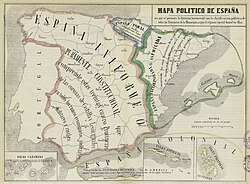
In an attempt to regionalize the peninsula, Patricio de la Escosura promulgated a decree on September 29, 1847 —which was suspended the same year—[7] the peninsula was divided into eleven general governments:
- Andalusia, capital Seville. Provinces of Seville, Cordoba, Cadiz and Huelva.
- Aragón, capital Zaragoza. Provinces of Zaragoza, Huesca and Teruel.
- Burgos, capital Burgos. Provinces of Burgos, Santander, Logroño and Soria.[8]
- Cantabria, capital Pamplona. Provinces of Navarra, Álava, Guipúzcoa and Vizcaya.
- Castilla la Nueva, capital Madrid and formed by the provinces of Madrid, Cuenca, Segovia, Guadalajara, Toledo and Ciudad Real.
- Castilla la Vieja, capital Valladolid. Provinces of Valladolid, León, Palencia, Salamanca, Zamora, Ávila and Oviedo.
- Catalonia, capital Barcelona. Provinces of Barcelona, Lérida, Gerona and Tarragona.
- Extremadura, capital Badajoz. Provinces of Badajoz and Cáceres.
- Galicia, capital La Coruña. Provinces of La Coruña, Pontevedra, Lugo and Orense.
- Granada, capital Granada. Provinces of Granada, Málaga, Almería and Jaén.
- Valencia and Murcia, capital Valencia. Provinces of Valencia, Murcia, Alicante, Albacete and Castellón.
1873

In 1873, during the First Spanish Republic, a draft Constitution was drawn up defining Spain as a Federal Republic, made up of seventeen States with legislative, executive and judicial power. According to articles 92 and 93, these "States" would have "complete economic-administrative autonomy and all the political autonomy compatible with the existence of the Nation", as well as "the power to give themselves a political Constitution". This constitution, whose text is mainly attributed to Castelar, was never adopted. As it was a federal Constitution, nothing was said about the provinces, as sub-divisions were to be defined by the member States. The first article of the draft reads as follows:
The States of Andalusia Alta, Andalusia Baja, Aragon, Asturias, Balearic Islands, Canary Islands, Castilla la Nueva, Castilla la Vieja, Catalonia, Cuba, Extremadura, Galicia, Murcia, Navarre, Puerto Rico, Valencia, Regiones Vascongadas compose the Spanish Nation.[9]
1884

Later, in 1884, Segismundo Moret presented a new bill on January 6, 1884, which distributed the peninsula and adjacent islands into fifteen administrative and political regions, approximating the distribution of the Territorial Audiences, which also failed. Its distribution was as follows:[8]
- Aragon: Huesca, Logroño, Zaragoza.
- Asturias: León and Oviedo.
- Balearic Islands.
- Canary Islands.
- Castilla la Vieja: Burgos, Palencia, Santander and Soria.
- Catalonia: Barcelona, Gerona, Lérida and Tarragona.
- Extremadura: Cáceres, Badajoz and Ciudad Real.
- Galicia: La Coruña, Lugo, Orense and Pontevedra.
- Granada: Almería, Granada, Jaén and Málaga.
- Madrid: Guadalajara, Madrid and Toledo.
- Murcia: Albacete, Alicante and Murcia.
- Seville: Cadiz, Cordoba, Huelva and Seville.
- Valencia: Castellón, Cuenca, Teruel, Valencia.
- Valladolid: Avila, Salamanca, Segovia, Valladolid and Zamora.
- Vascongadas: Álava, Guipúzcoa, Navarra and Biscay.
1891

Seven years later there was another attempt at regionalization which was not consummated either, in this case promoted by Francisco Silvela. By means of a Royal Order of July 20, 1891 and a Bill on the same date, he announced his intention to organize the government of the peninsula, the Canary Islands and the Balearic Islands into thirteen regions. This project foresaw that the regions would reach an important consideration as an autonomous entity and assigned them the following distribution:[10]
- Aragon: capital Zaragoza, also including Huesca, Logroño, Soria and Teruel.
- Asturias: capital Oviedo, also including the provinces of Santander and Gijón. The latter appears as a split of the former province of Oviedo.
- Balearic Islands.
- Canary Islands.
- Castilla la Nueva: capital Madrid, also including Cuenca, Guadalajara, Ávila, Toledo and Segovia.
- Castilla la Vieja: capital Valladolid, also including Burgos, León, Palencia, Salamanca and Zamora. Salamanca is divided in two and is shared with Extremadura.
- Catalonia: capital Barcelona, also including Gerona, Lérida and Tarragona.
- Cuba: capital Havana, also including Pinar del Río, Matanzas, Santa Clara, Puerto Príncipe and Santiago de Cuba.
- Extremadura: capital Badajoz, including also Cáceres, Ciudad Real and Salamanca (the rest of the province that is not in Old Castile).
- Galicia: capital La Coruña, also including Lugo, Orense and Pontevedra.
- Granada: capital Granada, also including Almería, Jaén and Málaga.
- Puerto Rico: capital San Juan.
- Seville: capital Seville, also including Cadiz, Cordoba and Huelva.
- Valencia: capital Valencia, also including Albacete, Alicante, Castellón and Murcia.
- Vascongadas: no capital defined. The capital would be chosen among the member provinces, which are Álava, Gipuzkoa, Navarra and Biscay.
Silvela's proposal would only materialize (and only briefly) in Cuba and Puerto Rico with the approval in 1897 of their respective autonomous charters.
The only four peninsular regions that maintained their limits in all the regionalization projects were Catalonia, Galicia, Granada (called Andalusia Alta in the 1873 Constitution) and Seville (called Andalusia in the Escosura project and Andalusia Baja in the 1873 Constitution).
1897
In an ephemeral way, a precedent for the regionalization of the administration began with the approval of:
- Autonomous Charter of Cuba.
- Autonomous Charter of Puerto Rico.
Regionalization in the Second Republic

With the assumption in 1931 of the Second Spanish Republic, the possibility was introduced in the Constitution for the regions that made up Spain to become autonomous regions. Thus, in 1932 Catalonia approved its Statute of Autonomy, while the Vascongadas provinces did not make this possibility effective until 1936, when the Basque Autonomous Statute came into force. In Galicia, the Draft Statute of Autonomy of Galicia of 1936 was also included, which was approved by referendum by the Galician people but which, on the outbreak of the Civil War, did not enter into force, although its text was delivered to the president of the Spanish Cortes and admitted for processing by the latter. In the rest of the historical regions there were only timid attempts to approve statutes of autonomy, which did not go beyond the draft stage. All the regions, both Autonomous (with statute) and Non-Autonomous (without statute), are recognized as such in the Organic Law of the Court of Constitutional Guarantees of 1933, which granted them the right to appoint a regional member.
Autonomous Regions
- Catalonia (1932): Barcelona, Girona, Lleida and Tarragona.
- Basque Country (1936): Álava, Gipuzkoa and Biscay.
- Galicia (1936): A Coruña, Lugo, Ourense and Pontevedra.
Non-Autonomous Regions
- Andalusia: Almeria, Cadiz, Cordoba, Granada, Huelva, Jaen, Malaga and Seville.
- Aragón: Huesca, Teruel and Zaragoza.
- Asturias: Oviedo.
- Balearic Islands: Balearic Islands.
- Canary Islands: Santa Cruz de Tenerife and Las Palmas.
- Castilla la Nueva: Ciudad Real, Cuenca, Guadalajara, Madrid and Toledo.
- Castilla la Vieja: Avila, Burgos, Logroño, Palencia, Santander, Segovia, Soria and Valladolid.
- Extremadura: Badajoz and Cáceres.
- Leon: Leon, Salamanca and Zamora.
- Murcia: Albacete and Murcia.
- Navarra: Navarra.
- Valencia: Alicante, Castellón de la Plana and Valencia.
Franco's dictatorship
With the end of the civil war and the dictatorship of Francisco Franco, the regions lose their political importance,[11] passing all territorial management to the deputations[12] and the Civil Governments of each province. The model of regions taught in schools was inherited from the separation of the Republic.
In 1958, the territories of Western Sahara and Ifni were established as provinces, the latter until 1969 (when it was ceded to the Kingdom of Morocco) and the former until 1976 (when it was evacuated and handed over to Morocco and Mauritania).
In 1964, the provinces of Rio Muni and Fernando Poo were organized in the Autonomous Regime of Equatorial Guinea, in force until its independence in 1968.
It was not until democracy in 1975 that it made sense again to speak of the regions of Spain.
State of the autonomous regions

The Spanish Constitution was approved in 1978, recognizing the right to autonomy for the regions and nationalities that make up Spain. Thus began the process of constitution of the State of Autonomies. On July 31, 1981, UCD and PSOE approved the autonomous pacts by which Spain is divided into 17 autonomous communities and 2 autonomous cities (the latter will officially become autonomous in 1995). Each autonomous region is divided into several provinces —except the uniprovincial ones— which are the same, except for minor modifications, as those of Javier de Burgos' division.
The nineteen autonomies are: Andalusia, Aragon, Balearic Islands, Canary Islands, Cantabria, Castile-La Mancha, Castile and León, Catalonia, Ceuta, Community of Madrid, Foral Community of Navarre, Valencian Community, Extremadura, Galicia, Melilla, Basque Country, Principality of Asturias, Region of Murcia, La Rioja.
See also
References
Notes
- ^ These circumscriptions created at the end of the 16th century in the Crown of Castile, which are sometimes called provinces, lacked any legal or administrative value and were merely fiscal in nature, so it is important to avoid confusing this concept of province with the current Provinces of Spain created in 1833.
Citations
- ^ Gomez Diaz, Juan. "División territorial de España Provincias y partidos judiciales" (PDF). Real Academia de Toledo (in Spanish): 4. Retrieved October 2, 2017.
- ^ Spain divided into provinces and intendancies, and subdivided into parties, corregimientos, alcaldías mayores, political and military governments, as well as realengos and orders, abadengo and señorío. Work formed by the original relations of the respective intendants of the kingdom, who were requested by order of HM by the Count of Floridablanca on March 22, 1785. With a nomenclator or dictionary of all the towns of the Reyno, which makes up the second part. Madrid: Imprenta Real. 1789 (in Spanish).
- ^ Martínez Díez, Gonzalo, p. 113
- ^ Estrada Sánchez, Manuel (2006). Provincias y diputaciones, la construcción de la Cantabria contemporánea (1799-1833) (in Spanish) (Servicio de Publicaciones de la Universidad de Cantabria ed.). Santander: Universidad de Cantabria, Parlamento de Cantabria. p. 26. ISBN 84-8102-428-7. Retrieved June 4, 2014.
- ^ Burgueño Rivero, Jesús (2012). "Las prefecturas de 1810" (PDF). Argutorio (in Spanish). Retrieved October 25, 2014.
- ^ Provisional division of Spanish territory of 27 January 1822 (in Spanish), Instituto de Historia, Consejo Superior de Investigaciones Cientificas (CSIC).
- ^ The regionalist attempt of Ibáñez Martín (1923) (in Spanish).
- ^ a b Molero, Juan Carlos, Public Spending and Fiscal Federalism in Spain. Period 1984–1998
- ^ Article 1 of the Federal Constitution of the First Spanish Republic of 1873: Componen la Nación Española los Estados de Andalucía Alta, Andalucía Baja, Aragón, Asturias, Baleares, Canarias, Castilla la Nueva, Castilla la Vieja, Cataluña, Cuba, Extremadura, Galicia, Murcia, Navarra, Puerto Rico, Valencia, Regiones Vascongadas.
- ^ Rubiales Torrejón, Amparo (1973). La Región: historia y actualidad (in Spanish). Sevilla: Inst. García Oviedo. p. 430. ISBN 978-84-6006-026-0. Retrieved February 23, 2010.
- ^ Aguilar, Maria (May 20, 2011). "La Geografía de España en 2º de Bachillerato: LA ESPAÑA DE LAS AUTONOMÍAS Y LA DIVISIÓN REGIONAL DURANTE EL FRANQUISMO (NO PAU)". La Geografía de España en 2º de Bachillerato (in Spanish). Retrieved May 13, 2017.
- ^ Prieto, Gonzalo (May 13, 2017). "La organización territorial de España en el siglo XX: el camino hacia las Autonomías | Geografía Infinita". www.geografiainfinita.com (in Spanish).
Bibliography
- García de Cortázar, Fernando (2005). Atlas de historia de España (in Spanish). ISBN 84-08-05752-9.
Additional bibliography
- Gómez Díaz, Juan (2008). "División territorial de España. Provincias y partidos judiciales. 175 años" (PDF). Toletum: Boletín de la Real Academia de Bellas Artes y Ciencias Históricas de Toledo (55): 151–175. ISSN 0210-6310. Archived from the original (PDF) on August 26, 2014.
- Zabaltza Pérez-Nievas, Xabier (2008). "La Vasconia peninsular y organización territorial española". Iura vasconiae: Revista de derecho histórico y autonómico de Vasconia (in Spanish) (5): 341–381. ISSN 1699-5376.
External links
- Programa Las Comunidades (Café para nadie), 25 de noviembre de 2012, Salvados, laSexta (In Spanish).
- Cómo se dibujaron las provincias en España(In Spanish), El Confidencial (31/12/2019)
- Así ha ido cambiando el mapa de las provincias españolas, clave en la desescalada (In Spanish)., El País (05/05/2020)
- Todos los pueblos, a menos de un día a caballo de su capital de provincia: así trazaron el mapa de España (In Spanish), La Sexta (14/05/2021)


